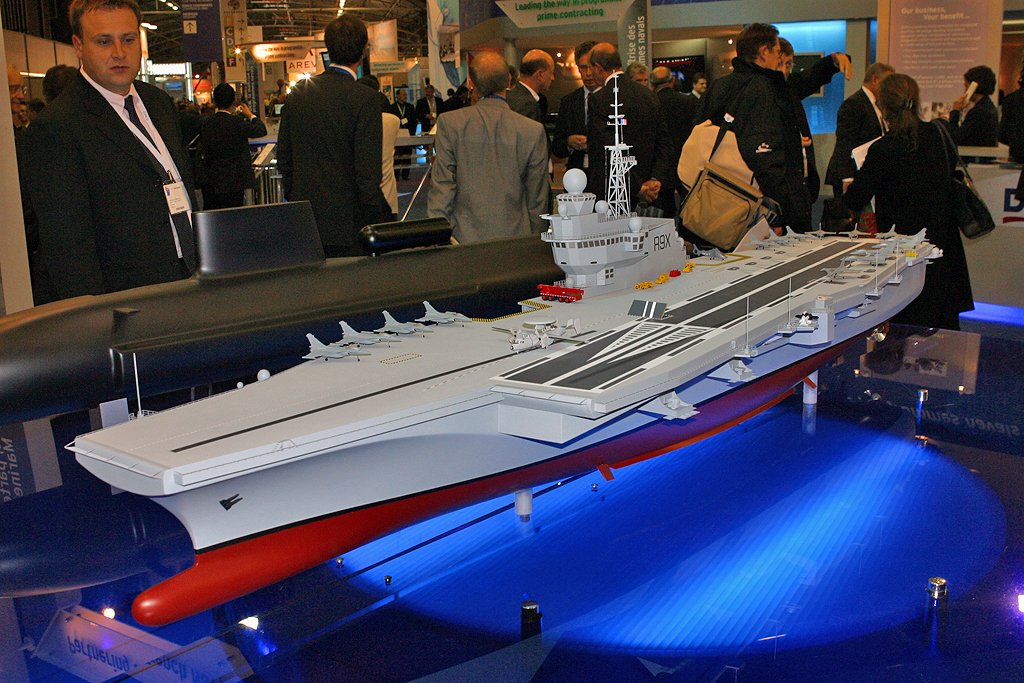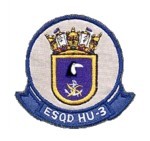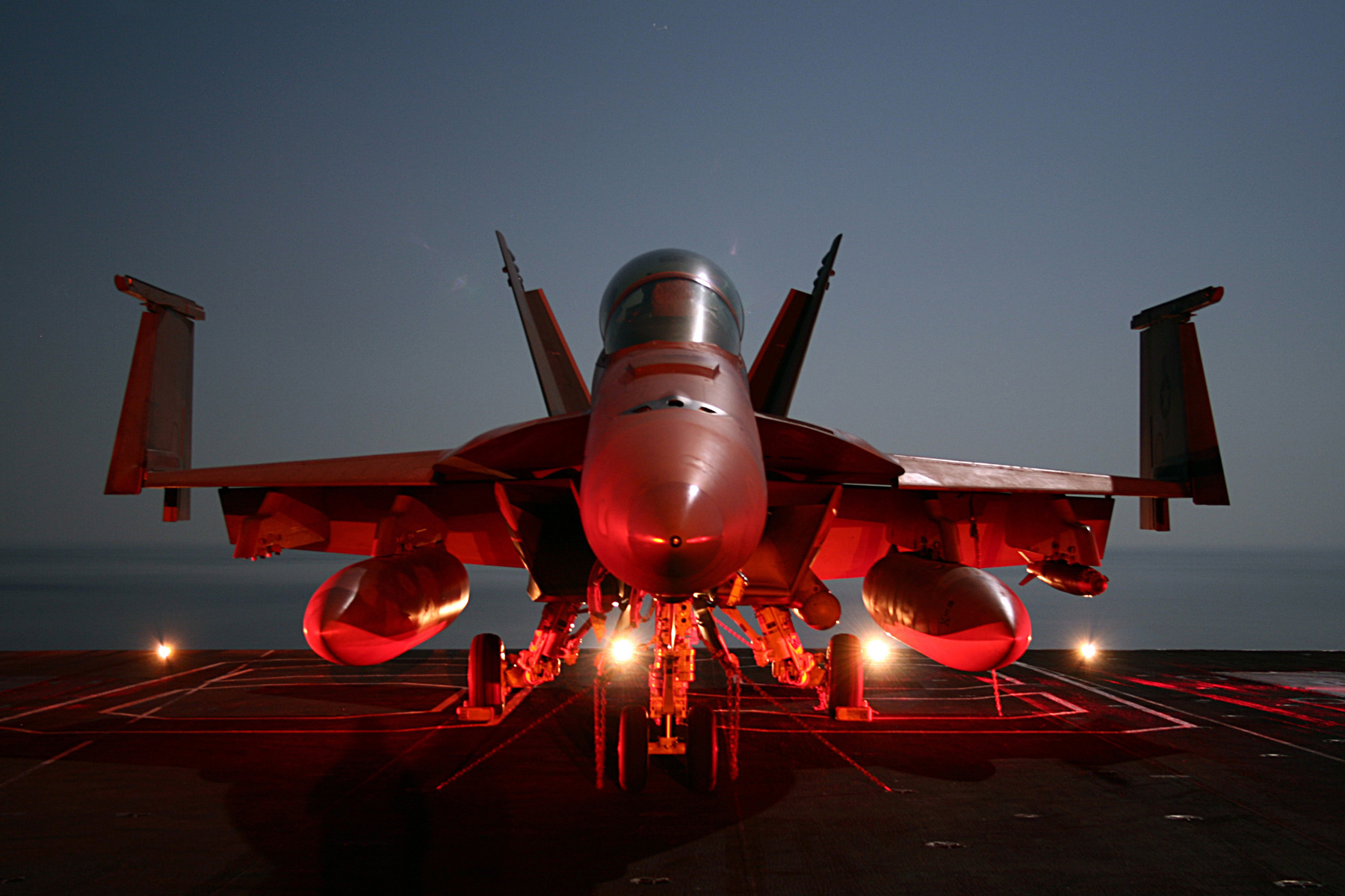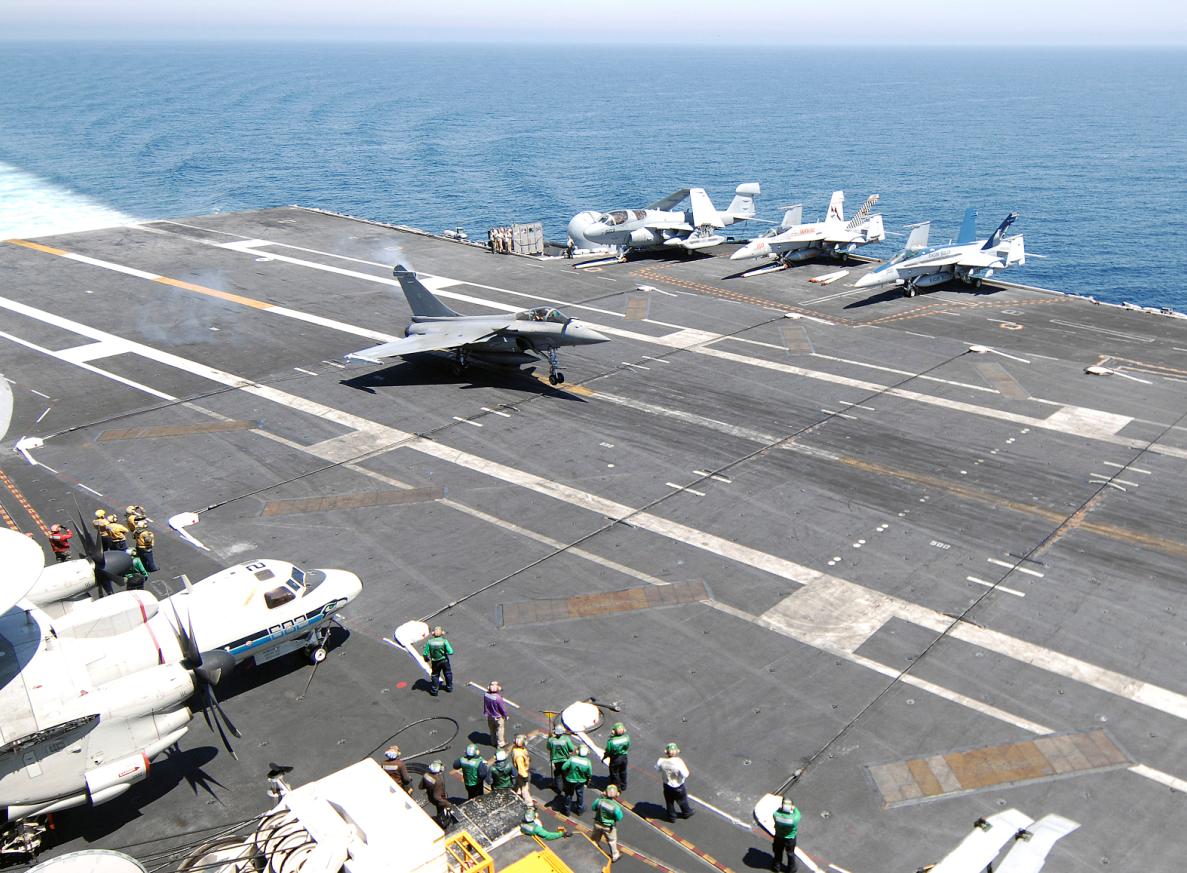FCarvalho escreveu:Alcantara escreveu:Toda a "pinta" de que a MB vai escolher uma versão "convencional" do CVN
Charles de Gaulle...
Characteristics
- Length (flight deck): 272 m
- Beam (flight deck) : 67.5 m (37.5 at waterline)
- Displacement : 52000t class
- Range: 5000 to 9000 nm
- Endurance: 5-week mission without replenishment at sea.
- Speed: 27 knots
- Crew (ship + air wing): 900+650
- Passengers : 220
Special attention has been paid to living conditions.
Propulsion architecture
- COGAG or CODLAG with 2 shaft lines
Aviation facilities (for 30 to 40 aircrafts such as Rafale, Hawkeye, NH90 or similar):
- 13700 m2 flight deck
- 2 x 90 m steam catapults
- 3 arresting gears
- 1 barricade for emergency recovery
- 4800 m2 hangar
- 2 aircraft elevators
Combat system
- SETIS
Main equipment (customizable configuration)
- 3D long-range multifunction radar
- 3D medium range multirole radar
- EW suite
- 8 surface-to-air missiles in VLS
- CIWS based on short missiles and/or small/medium gun
Fonte:
http://en.dcnsgroup.com/naval/products/ ... ctivetab=1
Trata-se deste aqui, ou seria uma versão menor?

Características:
Length : 285m
Weight : 62000 metric tons
Maximum Speed : 26 knt
Range : 8000 nm
power plant : 1 gas turbine and 2 diesel motors (3 shafts) + 2 steam plant for the 2 catapults
Airgroup : 32 Rafale M
fonte:
http://rafalenews.blogspot.com.br/2010/ ... -back.html
abs.
MENOR?
![[049]](./images/smilies/049.gif)
Não sei dizer com absoluta certeza, mas me parece ser o mesmo navio.
Se você for ver bem, os dois projetos devem possuir o mesmo comprimento. A diferença nas tabelas se deve simplesmente por metodologia (272 m de comprimento "no deque", mas, se for contar pelo "comprimento total do casco", entra na conta o "bulbo" do sonar... aí se chega nos 285 m).
A tonelagem é um pouco menor (PA2: 62000 tons / PA DSX: 52000 tons), mas mesmo assim o DSX aparentemente tem um melhor aproveitamento interno (carrega um pouco mais aeronaves, 40 contra 32).
DCNS and STX France offers a new design of aircraft carrier
It was one of the stars - discrete - the Euronaval. Result of the work led by DCNS and STX France since the abandonment of the Franco-British aircraft carrier in June 2008, the new "PA2" was unveiled last week on the stand of DCNS. The overall design of the building is reminiscent of the project "Juliette", initiated by DCNS before a cooperation agreement is signed by London and Paris in March 2006.
The new PA2 (aircraft carrier number 2) adopts a single island, which is preferred configuration of the Navy from the design to two islands of Carrier Vessel Future (CVF) of the Royal Navy. This unique structure, its architecture, optimizes aerology when a plane arrives at the landing. The building studied by DCNS and STX France
has a lift-off point of 272 meters long and 70 meters wide. As the Charles de Gaulle, the track has three strands oblique stop and a barricade system for the retrieval of a downed aircraft. The hull is characterized by an elongated bulb and, on the back, adding a skirt. This structure avoids the trim by the stern and easy maneuvering of aircraft in landing.
The tip of the bulb in the far back, the total length is 285 meters.
Moving the PA2 is, meanwhile, of 59,000 tons at full load (at Newbuilding). This building is lighter than the French version of CVF previously studied (65,000 tons).
However, the carrying capacity of aircraft are identical, with infrastructure sized to 32 Rafale, Hawkeye 3 and 5 helicopters. "We did lose weight. This design has the previous form of an improved hull. Generally, the boat has been optimized to best meet the needs of the Navy, but in a very strong prospect of reducing costs, "said one engineer. Officially, no figures were given but, in corridors, it evokes a bill reduced by about 20%. The focus is on the budget necessary for the implementation phase, but also operations, with less maintenance and fewer crews through automation. Thus, the crew of PA2 is given to 1690 persons, of which only 900 for the conduct of the building. This is down significantly compared to Charles de Gaulle. Although smaller (261 meters, 42,000 tons) and shipping fewer devices, the current French aircraft carrier is armed with just under 2000 people (including carrier air group).
Three rows of trees and a conventionally powered
PA2 has two boilers to supply two steam catapults 90 meters long. Not yet mature and probably more costly, the concept of electromagnetic catapults, intended to equip the new U.S. aircraft carriers, was not retained. The model presented by DCNS and STX adopts an all-electric propulsion, with three diesel generators, gas turbine and three electric propulsion motors. The whole develops 85MW, 64 MW for propulsion only, which should allow the carrier to spin at 26 knots. The concept of the three rows of trees can, in case of damage to one of these lines, maintain a speed of 20 knots, sufficient to receive a large aircraft like Hawkeye despite strong constraints (no wind flaps the failed unit). For French manufacturers, the new design PA2 is the best compromise can be reached between the French industrial capacities, the cost constraints of the Department of Defense and the Navy's operational requirements. Simple and robust, using, where possible civilian technologies (equipment "COTS" shelf), PA2 revisited this makes maximum use of materials made reliable. This is particularly the case for speed cameras, with the use of Herakles, already selected for the 11 future multi-mission frigates (FREMM) of the Navy. There are also above the bridge of a surveillance radar SMART-S, sold by Thales in many navies. The defense system is also limited to two quad launchers for Aster 15 and artillery remote operated small arms.
Me parece que a foto que você postou é a do projeto PA2. Já as minhas são as do PA DSX, o projeto (ou revisão de projeto) mais recente da DCNS. É esse o projeto que consta no site deles atualmente. Se você reparar, a "torre" do PA2 é de design um pouco mais antigo, tradicional. Já a do PA DSX é do tipo moderno, stealth.
No final das contas (além das perfumarias no design) a principal diferença entre PA2 e DSX é a redução da tonelagem total (lembrando que, pelo texto acima, o PA2 já havia sofrido revisão de projeto visando redução de peso) do casco atraves de mudanças no sitema de propulsão. A queda de 7000 toneladas verificada (59000 tons no PA2 "revisado" contra 52000 no PA DSX) seria condizente com a simplificação que o sistema de propulsão Diesel-elétrico pode proporcionar (menos partes móveis, menos aço, menos peso, rsrsr...

).















